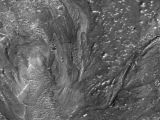According to astronomers investigating the pictures sent back by the High Resolution Imaging Science Experiment (HiRISE) camera aboard the Mars Reconnaissance Orbiter (MRO), it would appear that areas near the Hale crater, on the surface of the Red Planet, are laden with channels. In a view that covers an area about two miles (three kilometers) wide, the landscape features are clearly visible, and this has puzzled experts. Associations between craters and channels are uncommon to say the least. Planetary scientists propose a number of unusual explanations for their formation, PhysOrg reports.
Once thought to be an extremely rare occurrence, more and more channel-crater systems have been discovered on Mars over the past few years, as MRO covered increasingly large portions of the planet's surface. Impacts by comets or precipitation caused by the impact events themselves are two of the most commonly circulated explanations for the formation of the channels, although no one can say for sure precisely how they were formed, and why.
The recently discovered formations are located on the northern rim of the Argyre basin. The Hale crater is exceptionally well preserved for its age, and has a size of 125 by 150 kilometers (78 by 93 miles). The formation is located about 70 kilometers (100 miles) to the Southeast of the channels that are seen in the second, black-and-white image. The peculiar formations in the second image are estimated to be about 250 meters (820 feet) across, though most of them are probably much smaller than that. A larger collection of photos of the channels can be seen here.
Experts now believe that these structures were, indeed, formed by impact events. It's a widely known fact that the Martian underground houses large amounts of ice. A strong-enough impact may have heated enough water-ice to create streams. These bodies of water would have carved the channels in the crater's vicinity, until their sources would have frozen over again. At that point, the flow stopped, and only the channels were left behind. The new find also has a significant implication for Mars' past. If the impact was enough to cause the run-off, then the planet might have not had a long-term, stable, warm and wet climate.

 14 DAY TRIAL //
14 DAY TRIAL // 
